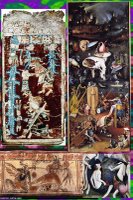(26) Peter Martyr and the Dresden Codex
 Once it begins to be deciphered, El Jardín de las Delicias/The Garden of Delights starts to match a description by Peter Martyr (Pietro Martiro d' Anghiera) in De Nuper sub D. Carolo repertis insulis (1521), pp. 33-34, which Michael Coe has proposed represents the Dresden Codex. I have re-translated since some translations omit the stars (stellis):
Once it begins to be deciphered, El Jardín de las Delicias/The Garden of Delights starts to match a description by Peter Martyr (Pietro Martiro d' Anghiera) in De Nuper sub D. Carolo repertis insulis (1521), pp. 33-34, which Michael Coe has proposed represents the Dresden Codex. I have re-translated since some translations omit the stars (stellis):The characters are very dissimilar to ours, dice, hooks, snares or nooses, outlines, stars, and similar forms, written in lines in our fashion: almost to rival the forms of the Egyptians: between the lines they depict men, and types of animals, particularly the king and also prominent people: for that matter it can be believed that greater accomplishments are recorded there for their own king, as it is in our time. We often see them insert figuras [illustrations?] in general histories, and also mythical codices, concerning the same matters, and the story is that this is for the alliciendos to gratify the wishes of authors who want them, also the way the outer panels are pleasingly put together looks no different when they are closed than ours: also law, and sacrifices, and ceremonial rites, astronomical notations, and certain computations, and cycles and times for sowing, are entrusted to books.
…Sunt characteres a nostris ualde dissimiles, taxillis, hamis, laqueis, limis, stellisque ac formis eiusmodi, lineatim exarati nostro more: Aegypti as fere formas aemulantur: Interlineatim hominú, animeliumque species, regum praecipue ac procerú dipingunt: quaere credendum est gesta esse ibi maiorum cuiusque regis conscripta, quaeadmodum nostra sit tempe state. Vedemus saepenumero eos generalibus historijs, fabulosis etiam codicibus, ipsius rei, quae narratur, ad alliciendos emere cupientium animos authorum, figuras interserere, artequoque grata superiores tabulas cópingút, nil differe a nostris clausi videntur: legú quoque, & sacrificiorú, ceremoniarúque ritus, astronomicalque annotationes, & cóputationes quaesdá, seminandique rónes & toa, libris cómendát…
See Michael D. Coe, “The Royal Fifth: Earliest Notices of Maya Writing,” Research Reports on Ancient Maya Writing 28 (1989):1-10.


0 Comments:
Post a Comment
<< Home